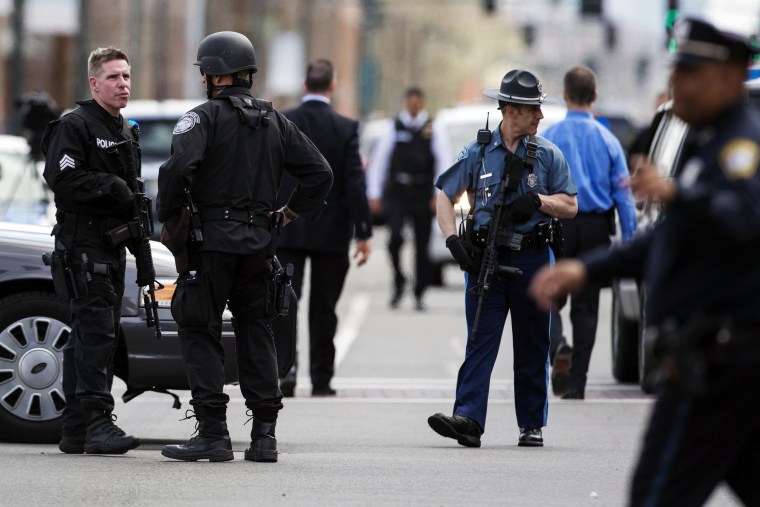An official analysis of authorities' handling of the 2013 Boston Marathon bombing condemns a largely uncontrolled response from some of the 2,500 police officers who took it upon themselves to show up at the scene of a shootout with suspects Dzhokhar and Tamerlan Tsarnaev.
The uncoordinated response contributed to a chaotic scene where one transit cop was gravely wounded and two others were mistakenly fired on by colleagues, the analysis said.
The 126-page "after-action" report, a collaboration of several local and state agencies, including the city of Boston and the Massachusetts State Police, blames poor weapons discipline for "dangerous crossfire situations" involving some of the officers who shot toward the suspects without identifying a target. Other officers joined the volley from both sides of a narrow residential street.
More than a dozen officers suffered minor injuries during the April 19, 2013 shootout, the culmination of a four-day hunt for the Tsarnaev brothers. But none of the officers is believed to have been wounded by the suspects, NBC News reported last year.
Massachusetts Bay Transportation Authority Police Officer Richard Donohue was hit in the groin by a police bullet and nearly bled to death.
The report does not point to a specific individual who may have shot Donohue. It only says, "as the second suspect fled the scene, a responding officer from the Transit PD was shot and critically wounded."
RELATED: How Shootout With Bombing Suspects Spiraled into Chaos
Due to the amount of police vehicles near the shootout scene, a Watertown police officer had to drive the ambulance that took Donohue to a local hospital, the report says. This move allowed the paramedics to focus on Donohue instead of navigating the maze of police cars.
Also documented in the report is the story of an unmarked black Massachusetts State Police pickup truck that had been incorrectly reported stolen.
"The truck was spotted driving on Adams Street, a few blocks from the firefight, with two occupants. An officer witnessing the vehicle fired upon it. Upon further inspection, it was determined that the occupants of the vehicle were a (Boston Police Department) officer and (Massachusetts State Police) trooper in plain clothes. They were unhurt."
In the end, investigators counted more than 2,500 state and federal law enforcement personnel from across the region who responded to the shootout and manhunt, which ended with Tamerlan Tsarnaev dead and Dzhokhar Tsarnaev pulled from a boat parked behind a Watertown home. Dzhokhar Tsarnaev is now on trial for the attacks.

Some of the officers took part in the shootout without notifying their own department supervisors, the report said.
"It must be part of police training throughout the state that in complex, large incidents or multiple incidents, an officer does not respond unless requested by an official with the authority to make such a request," the report says.
During the firefight, the radio systems and the ability of those systems to operate among departments performed well, although there was undisciplined chatter among officers. The one radio issue noted was the lack of interoperability between federal officials and local law enforcement.
The shootout was by far the most heavily criticized aspect of the response to the April 15, 2013 bombings.
The report concluded that the Boston area hospitals were well prepared and the police did a good job of keeping cars out of key evacuation routes from the bombing. The report also praised the efforts of the EMS system and coordination plans. "This coordination resulted in no one single hospital in the area being overwhelmed," the report said.
But the report did indicate problems with hospital security. "As the hours and days wore on, the presence of law enforcement in hospitals greatly decreased even though the suspects remained at large. Hospitals security departments were left feeling understaffed and vulnerable as hospital security officers are generally unarmed."
Boston Mayor Martin Walsh said in a statement Friday that he was proud of what the report praised and that the city was learning from its missteps.
"I know that over the past two years city departments have worked together diligently to take the lessons learned from the bombings and drastically improve our emergency response protocols so we are even better prepared for the future, and we can set the example for other cities," Walsh said.
